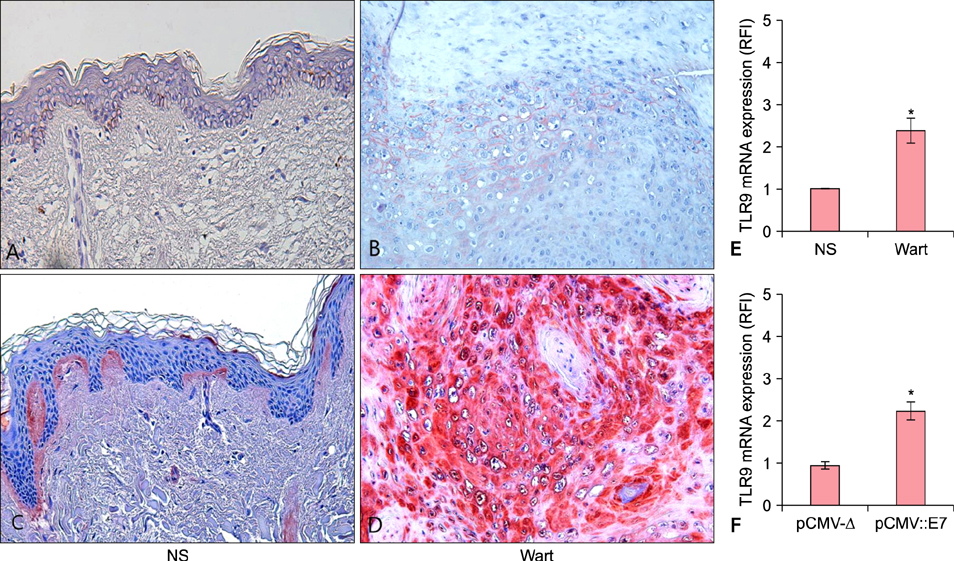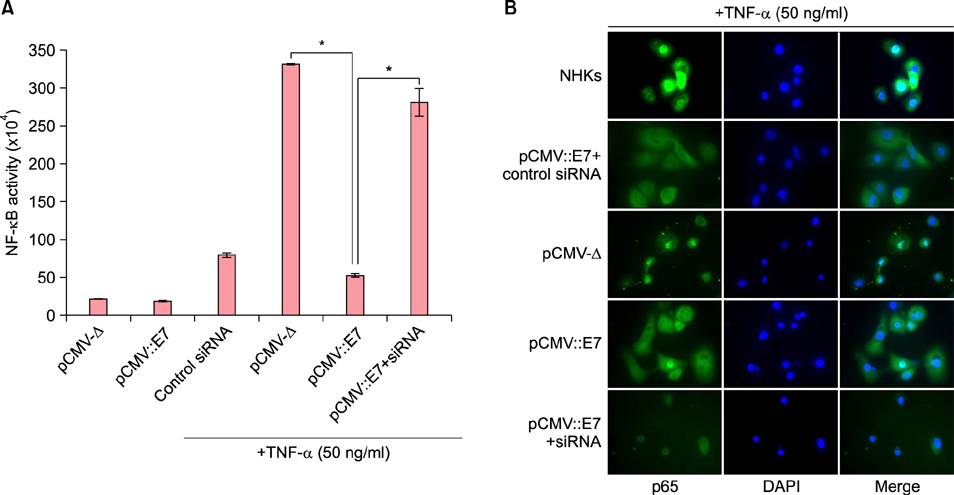Ann Dermatol.
2017 Jun;29(3):367-370. 10.5021/ad.2017.29.3.367.
Attenuated Nuclear Factor Kappa B Activity by E7 Protein of Human Papillomavirus Type 2 in Human Epidermal Keratinocytes
- Affiliations
-
- 1Department of Dermatology, Seoul St. Mary's Hospital, College of Medicine, The Catholic University of Korea, Seoul, Korea. yymmpark6301@hotmail.com
- 2Department of Biological Sciences and Biotechnology, Hannam University, Daejeon, Korea.
- KMID: 2378546
- DOI: http://doi.org/10.5021/ad.2017.29.3.367
Abstract
- No abstract available.
MeSH Terms
Figure
Reference
-
1. Stanley MA. Epithelial cell responses to infection with human papillomavirus. Clin Microbiol Rev. 2012; 25:215–222.
Article2. Zekan J, Skerlev M, Milić L, Karelovć D. Human papillomavirus-related diseases of the female lower genital tract: oncogenic aspects and molecular interaction. Coll Antropol. 2014; 38:779–786.3. McLaughlin-Drubin ME, Münger K. The human papillomavirus E7 oncoprotein. Virology. 2009; 384:335–344.
Article4. Oeckinghaus A, Hayden MS, Ghosh S. Crosstalk in NF-κB signaling pathways. Nat Immunol. 2011; 12:695–708.
Article5. Ku JK, Kwon HJ, Kim MY, Kang H, Song PI, Armstrong CA, et al. Expression of Toll-like receptors in verruca and molluscum contagiosum. J Korean Med Sci. 2008; 23:307–314.
Article6. Choi Y, Kim DH, Jin SY, Lee AY, Lee SH. Topical immunotherapy with diphenylcyclopropenone is effective and preferred in the treatment of periungual warts. Ann Dermatol. 2013; 25:434–439.
Article7. Kim SY, Jung SK, Lee SG, Yi SM, Kim JH, Kim IH. New alternative combination therapy for recalcitrant common warts: the efficacy of imiquimod 5% cream and duct tape combination therapy. Ann Dermatol. 2013; 25:261–263.
Article8. Vandermark ER, Deluca KA, Gardner CR, Marker DF, Schreiner CN, Strickland DA, et al. Human papillomavirus type 16 E6 and E 7 proteins alter NF-kB in cultured cervical epithelial cells and inhibition of NF-kB promotes cell growth and immortalization. Virology. 2012; 425:53–60.
Article9. Valentine R, Dawson CW, Hu C, Shah KM, Owen TJ, Date KL, et al. Epstein-Barr virus-encoded EBNA1 inhibits the canonical NF-kappaB pathway in carcinoma cells by inhibiting IKK phosphorylation. Mol Cancer. 2010; 9:1.10. Sloan E, Henriquez R, Kinchington PR, Slobedman B, Abendroth A. Varicella-zoster virus inhibition of the NF-κB pathway during infection of human dendritic cells: role for open reading frame 61 as a modulator of NF-κB activity. J Virol. 2012; 86:1193–1202.
Article
- Full Text Links
- Actions
-
Cited
- CITED
-
- Close
- Share
- Similar articles
-
- Expression and localization of human papillomavirus type 16 E6 and E7 open reading frame proteins in human epidermal keratinocyte
- The effects of wild type p53 tumor suppressor gene expression on the normal human cervical epithelial cells or human epidermal keratinocytes transformed with human papillomavirus type 16 DNA
- Degradation of the Retinoblastoma Tumor Suppressor Protein by the Human Papillomavirus-16 E7 Variants
- Improved immunodetection of human papillomavirus E7
- Expression of Human Papillomavirus Type 16, Prototype and Natural Variant E7 Proteins using Baculovirus Expression System



